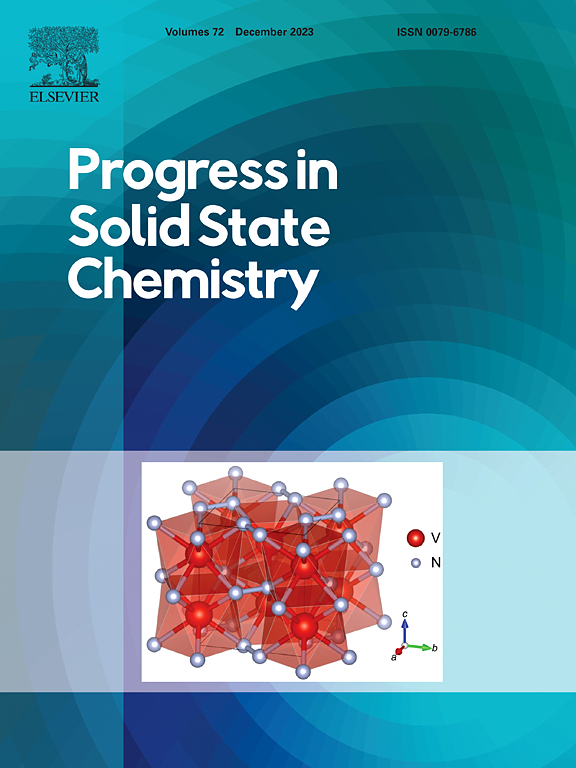钴蓝颜料的制备、应用及调色机理研究进展
IF 10.5
2区 化学
Q1 CHEMISTRY, INORGANIC & NUCLEAR
引用次数: 0
摘要
钴蓝(CoAl2O4)颜料是一种知名的尖晶石结构高端蓝色无机颜料,其着色性能强、蓝色色度理想、化学稳定性好,在无机或有机蓝色颜料中都是不可替代的。因此,为了满足不同应用领域的需求,人们开发了一系列的策略来制备CoAl2O4颜料,包括常见的固相法、液相法和气相法。然而,由于钴源稀缺导致的高成本以及高温结晶过程中CoAl2O4颗粒的聚集,在一定程度上限制了其颜料的相关应用。有趣的是,稳定的无机基质的掺入有助于降低生产成本,控制CoAl2O4纳米颗粒的尺寸和蓝色强度,特别是掺入天然或废弃的非金属矿物资源。因此,本文结合文献和本人的研究成果,对近年来CoAl2O4颜料的合成、相关应用及调色机理等方面的研究进展进行综述。重点介绍了不同合成方法的合成机理、结构与应用性能之间的关系,特别是所设计的CoAl2O4/硅酸盐杂化颜料的结构组成和颜色性能。最后,对未来的发展趋势提出了建议,并对其他环保型无机颜料提出了建议。本文章由计算机程序翻译,如有差异,请以英文原文为准。

Recent advance in preparation, applications and color regulation mechanism of cobalt blue pigment
Cobalt blue (CoAl2O4) pigment is a well-known high-end blue inorganic pigment with a spinel structure, and it is irreplaceable in the blue pigments either inorganic or organic ones due to its strong coloring performance, desirable blue chroma, and excellent chemical stability. Therefore, a series of strategies have been developed for the preparation of CoAl2O4 pigment including common solid-phase method, liquid-phase and gas-phase technologies to meet the requirements of different application fields. However, the relevant applications of CoAl2O4 pigment are restricted at a certain degree due to the high cost derived from the scarcity of cobalt sources as well as the aggregation of CoAl2O4 particles during the high-temperature crystallization process. Interestingly, incorporation of stable inorganic substrates facilitates the decrease in the production cost and the control of the size and blue intensity of CoAl2O4 nanoparticles, especially incorporation of natural or waste nonmetallic mineral resources. Therefore, this review provides an overview of the recent advance in the synthesis, relevant applications and color regulation mechanism of CoAl2O4 pigment combining with the literatures and our research achievements. It is mainly focused on the synthesis mechanism of different methods, and the relationships between the structures and the application performances, especially the structural composition and color performance of the designed CoAl2O4/silicate hybrid pigments. Finally, several suggestions are proposed for the future development trend on CoAl2O4 pigment and even other eco-friendly inorganic pigments.
求助全文
通过发布文献求助,成功后即可免费获取论文全文。
去求助
来源期刊

Progress in Solid State Chemistry
化学-无机化学与核化学
CiteScore
14.10
自引率
3.30%
发文量
12
期刊介绍:
Progress in Solid State Chemistry offers critical reviews and specialized articles written by leading experts in the field, providing a comprehensive view of solid-state chemistry. It addresses the challenge of dispersed literature by offering up-to-date assessments of research progress and recent developments. Emphasis is placed on the relationship between physical properties and structural chemistry, particularly imperfections like vacancies and dislocations. The reviews published in Progress in Solid State Chemistry emphasize critical evaluation of the field, along with indications of current problems and future directions. Papers are not intended to be bibliographic in nature but rather to inform a broad range of readers in an inherently multidisciplinary field by providing expert treatises oriented both towards specialists in different areas of the solid state and towards nonspecialists. The authorship is international, and the subject matter will be of interest to chemists, materials scientists, physicists, metallurgists, crystallographers, ceramists, and engineers interested in the solid state.
 求助内容:
求助内容: 应助结果提醒方式:
应助结果提醒方式:


